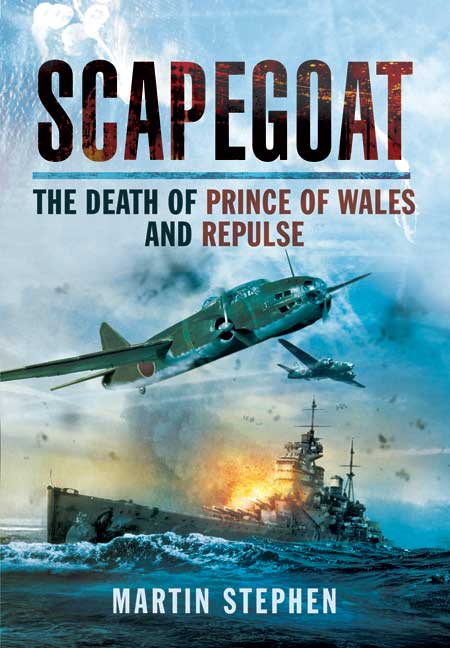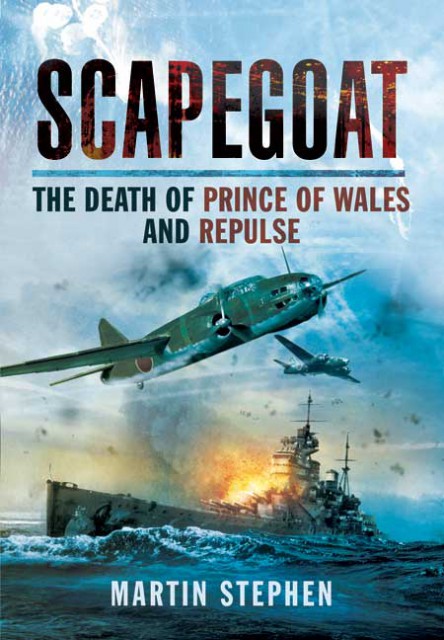The loss of Britain’s imperial possessions in the Far East at the end of 1941 and in to the next year was nothing less than a catastrophe, but it is chiefly remembered as the beginning of the end of two centuries of empire when the huge loss of face coupled with the impoverished state of British power was abundantly clear to all and sundry.
While the fall of Singapore remains the abiding image of the disaster it was the sinking of the modern battleship Prince of Wales and the venerable battlecruiserRepulse that was seen as the end of any real hope of stopping Japanese conquest of the region. This was an age when capital ships projected power and the sinking of the two vessels signalled so much more than the actuality of their loss.
The conventional telling of the story takes us into threatening waters with an admiral unwilling to believe in the realities of modern air power leading his fleet to destruction. The author challenges all this by stripping down the known facts of the story along with analysis of the tawdry aspects of reputations, jealousies and motives in the higher echelons of the Royal Navy. In short he asserts that because Phillips went down with his ships he was a ready scapegoat for men who profited from putting all the blame for the disaster on him.
Author Martin Stephen is fully aware he has a mountain to climb to turn longstanding perceptions or alter what has become established fact with an impassioned reassessment of how and why the ships were lost and more importantly the rehabilitation of the much maligned Admiral Sir Tom Phillips, the scapegoat of the title.
Mr Stephenrecognises that previous works on this tragedy have more or less set in stone the history of what happened in the period leading up to the disaster of 10th December 1941. He has identified that one book in particular, Martin Middlebrook and Patrick Mahoney’s Battleship has pretty much cornered the modern telling of the story. I have to agree with him because the book is one of my desert island reads, it is convincing and, I have to say, seemsbalanced and genuine. It remains one of my very favourite history books.
Mr Stephen sets out to challenge the portrait of Tom Phillips painted in Battleship, which in fairness came about because all historiography builds on the work of others and the sources available. With this in mind it was difficult not to draw the conclusion that Phillips’ obstinacy and antiquated ideology led to the destruction of the two capital ships.
Tom Phillips was a senior Staff officer in the Royal Navy and had been a friend and confidant of Winston Churchill, the man whose trail inevitably wanders across the full breadth of this story easily allowing notions of cover ups and scapegoats to foment with his mere presence in the saga of a disaster.
There are some significant points to address. Phillips’ experience told him that well handled ships could negate the impact of air power. His comments on this have been conveniently used against him at every turn and it isn’t difficult in light of them to see why they have been so convincing. The author attempts to show that these quotes were redundant by the time Prince of Wales left South Africa for the Indian Ocean, and reveals Phillips had completely revised his opinions by then.
The chaos in Singapore and the woeful state of the RAF there are well known. Intelligence was negligible and the British had been woefully unaware of Japanese strengths or intentions. The golden gift of hindsight is not required to appreciate a squadron of Brewster Buffalo fighters could never be considered adequate defence against any modern air forces. The author asserts that Admiral Palliser in Singapore made confusing signals to Phillips telling him his ships would have no air cover, when in fact the Buffaloes, for all they were worth, were available.
Coordination between British forces was so poor the author argues Phillips would not have known of the Japanese threat to his fleet – Force Z. The fleet had sailed without any cruisers or adequate numbers of destroyers. Rival admirals of the unpopular Phillips had sent out obsolete ships to his force to get shot of them. Jealous admirals disliked and mistrusted Phillips because of his senior Staff position. His short stature and high intelligence were denigrated within the service where athletic prowess and manliness mattered more than brains.
The author contests whether the modern carrier Formidable had ever been intended to join Force Z in the first place regardless that it was seriously damaged working up in the Caribbean. The fact that the ancient and unsuitable Hermeswas in South Africa at the same time as Prince of Wales is a red herring.Neither of these carriers joined Force Z but Formidableis indelibly linked to Force Z.
We learn a good deal about the true state of the two ships. Prince of Waleshas long been cast as a Jonah because of her unfortunate involvement in the loss of the iconic Hoodin battle with the Bismarck in May, 1941.Prince of Walessuffered continuous mechanical problems with her main armament and the author asserts that dockyard bomb damage allied to her poor design, a compromise born out of inter war limitation treaties; along with alack of working up time with a largely hostilities only crew contributed to her eventual demise.
Repulsewas a different matter altogether. Crewed by experienced regulars, the limitations of her age and armament ultimately exposed her to destruction, but this was one of the finest fighting ships in the Royal Navy at that time and her performance in the moments up to when she was struck by torpedoes was incredible. The reputation of Repulse and her crew is as inviolate as the hapless Prince of Wales is the complete opposite.
The author challenges the very reason that Force Z was sent to the Far East in the first place. The accepted image is that the ships were purely a blunt instrument to fight the Japanese should the need arise. Mr Stephen argues that the ships were really on a diplomatic mission to calm fears in Australasia and more importantly to impress the Americans with whom there was discussion of forming a naval alliance whereby a combined fleet would operate from Singapore rather than be isolated in the way things actually turned out from December 7th onwards. When Prince of Wales arrived in Ceylon to join Repulse, Phillips flew to Manila to confer with the American Admiral Hart and it is important to recognise this is before the war with Japan had started. Phillips was a highly experienced Staff officer and the author contests he was given command of Force Z not for his fighting skills but because of his abilities at diplomacy and his clarity of thought. Interesting stuff.
Within the Admiralty there had been disagreements over what British ships should have been sent out to the Far East and it might have been that Force Z would have been bolstered by a significant number of aging but nonetheless potent capital ships to impress upon the Americans that Britain meant business. While the Americans had agreed to base some destroyers in Singapore, events overtook the plan and definitively proving the existence of a much more significant naval alliance remains problematic.
I have to say I find a good deal of Mr Stephen’s passionate arguments quite convincing and any challenge to accepted history presented in a way such as this will always be a good reason to reassess things. It is easy to find favour in his contention that the death in combat of Tom Phillips and the untimely death of his mentor Sir Dudley Pound in 1943 allowed Phillips to take all the blame for the disaster off Malaya. This was convenient for rivals who had made poor decisions and who were resentful of his intellect as much as it was for Winston Churchill who had set the whole plan in motion in the first place.
As soon as hostilities began the two ships should have been withdrawn and saved for future operations. But the decision to do this had to be made by the Admiralty in London and blaming Phillips for not prudently hightailing it is unfair. He was like any admiral of his time, predestined to fight because decency and honour required it. No other option was available to him.
I like this book. I could use more convincing proof that a naval alliance between Britain and the USA was seriously on the table but I can see how admirals Cunningham, Layton and Somerville would profit from pinning all the blame on Phillips to cover up their own faults. There is a lot more to the story and the reader will have to decide for themselves how many of these elements help argue the case for Tom Phillips or are just convenient. The fact Mr Stephen had access to the admiral’s papers, long thought to be lost or non-existent, is telling. But this fact alone is not the haymakerthe argument really needs in its corner.
Whether Tom Phillips was the dinosaur he is painted to be or not, Force Z was destroyed because of a combination of factors that cannot conceivably be all his fault. I don’t believe that even the Middlebrook and Mahoney book attempts to assert this as fact but Phillips’ pre-1941 view of air power works against him. That he apparently fell out with Churchill over strategic bombing and the disastrous waste of naval shipping in Greece and Crete may not be that important either. His friend Arthur ‘Bomber’ Harris made the classic joke of him that he would be standing on a box on the bridge of his ship as it sank under air attack while blaming it on a mine. This teasing has helped damn the diminutive Tom Phillips.
Phillips and Captain Leach of the Prince of Wales were lost when the doomed battleship capsized. Notions that Phillips deliberately surrendered his life because of a sense of guilt can be ignored. He was a brainy little bloke with marked opinions his contemporaries chose not to agree with and his long Staff career set him up to be disliked by the saltier and considerably less erudite admirals politicking around him. I can’t say for certain Phillips can be restored on the strength of this book, however much I enjoyed it or found the arguments convincing.
Despite the author’s undoubted sincerity, it is important you read other books as well and inevitably my thoughts turn to Middlebrook and Mahoney because their classic means so much to me. I need to point out as an aside that there are several typos throughout and one bad factual error early in the book that must be just a slip the editor missed, but none of this ever helps a good argument and it diminishes confidence. However, it didn’t put me off finishing the book or appreciating the effort put into it.
Just a short time ago a Malaysian naval vessel arrested a boatload of Vietnamese scrap metal thieves who had been diving on the wrecks of Prince of Wales and Repulse unconcerned that they are war graves. The two ships are said to have been heavily stripped to the point where there won’t be very much left in the near future. This should cause offence here in the UK and it certainly is a sad reflection on our modern world but it will never take anything away from the sacrifice of the men of Repulse and Prince of Wales who died on 10th December 1941. The author tells us that in death Tom Phillips had his reputation stolen and now his ships, too, are the subjects of thieves. It’s a cruel world.
Reviewed by Mark Barnes for War History Online.
SCAPEGOAT
The Death of Prince of Wales and Repulse
By Martin Stephen
Pen & Sword Maritime
ISBN: 978-1-78383-178-4

